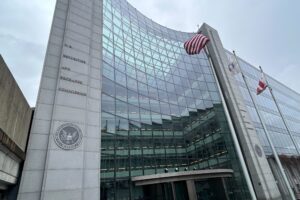
In 1988, Congressional testimony from NASA’s Dr. James Hansen helped cement the words “climate change” in the national consciousness. In 2015, nearly 200 countries met in Paris to pledge to address the problem. But 2020, the year the skies over San Francisco turned a sick shade of orange, the Earth’s temperature hit its highest ever, the Atlantic hurricane season smashed records, and nearly every state west of the Mississippi suffered severe drought, may well be remembered as the year it finally hit home.
Across the U.S., state and local governments and the bond market that helps them do business are coming to grips with a situation that can’t be ignored any longer. They’re taking increasingly proactive, if piecemeal, steps toward making their communities ready for extreme weather and pollution scenarios that once seemed unimaginable.
“I feel like there’s been a revolution in the past year in terms of thinking about climate change,” said Kevin DeGood, director of infrastructure policy at the left-leaning Center for American Progress. “What’s that old saying — everything seems impossible until it happens, and then it feels inevitable?”
But “inevitable” doesn’t mean “settled,” and right now preparedness is patchwork and, arguably, too limited. There’s no way to tabulate what’s being done, let alone what should be done, which means assigning dollar figures to either is daunting.
No state untouched
A recent report from the Environmental Defense Fund offers a few reminders of how costly climate change has already been, and an acknowledgement that it may only become more expensive from here.
The U.S. Government Accountability Office estimates that between 2005 and 2019, the federal government has spent an average of $30 billion per year on “weather disaster assistance.” All 50 states have suffered from at least one billion-dollar weather disaster, and North Carolina, Georgia, Alabama, Mississippi and Texas — home to some of the fastest-growing regions in the country — have each endured billion-dollar crises in every category of disaster: hurricanes, severe storms, floods, winter storms, freezes, droughts and wildfires.
Read: The top U.S. cities labeled as dangerous ‘heat islands’ include a few small-population surprises
In a 2020 report, DeGood argued that the enormity of the issue required a coordinated national response, a set of broad best practices that takes into account everything from engineering to insurance.
“What I was trying to say is, this is beyond the analytical capability of any standard borrower,” he said in a recent interview with MarketWatch. “It’s not as if Miami-Dade County knows how to run climate models. What we need for this to become more meaningful is a multi-agency working group meeting over a couple of years.”
Opinion: Miami’s $6 billion sea wall won’t save the city from flooding — green hybrid designs make more sense
DeGood doesn’t mean anything against Miami-Dade, per se: he used one of its 2019 bond deals in his 2020 paper to illustrate the challenges issuers face. In fact, the county recently appointed a Chief Heat Officer to address the impacts of heat, hurricanes, floods, and sea level rise, among other things. It’s just that, as he writes in the paper, “climate change is the greatest collective action problem the world has ever encountered.”
The Center for American Progress was just one participant in a larger group of advocates that wanted the Biden administration and its congressional allies to direct more than $2 trillion on measures spanning clean-energy tax credits, water infrastructure, nuclear-energy incentives, electric buses and more programs that could change the budget landscape for state and local governments.
President Joe Biden has made climate change a priority through executive actions, bilateral and multilateral global cooperation and reversing some Trump-era regulatory rollbacks, but a paper-thin Democratic majority on Capitol Hill has meant many of the more robust climate-change initiatives were stripped or sharply reduced from infrastructure and budget legislation that continues to make its way through Congress.
See: Climate change is huge risk for the American financial system, a major new bipartisan report says
Beware one-size-fits-all
But for participants in the $3.9 trillion municipal-bond market, who have perhaps the best aggregate lens on what’s going on locally, the individual nature of our communities calls for bespoke responses.
U.S. municipal green-labeled debt is expected to comprise a larger share of the municipal market this year, from 3.4% of total municipal issuance in 2020 to 4.1% in 2021, according to S&P Global Ratings. Some $15 billion of green muni bonds were issued in 2020 in spite of the pandemic, according to a report from the Climate Bonds Initiative.
On average, sustainable debt’s share of total municipal market issuances increased 51% per year from 2014 through 2020.
Read: Yellen keeps up push for greater U.S. climate-change regulation, rebuffing concerns of Republicans
“The caution about the muni market is that it’s not one-size-fits-all,” said Colin MacNaught, founder and CEO of BondLink, a service for muni-bond issuers. American localities differ on everything from existing climate and geography to demographics to political views on how much government should respond.
And in contrast to DeGood, who continues to think we haven’t yet hit the exogenous shock that will jolt everyone into action, MacNaught thinks that’s already happening in the bond market. There’s admittedly wide variety in how robustly issuers address climate-risk disclosures, but many are doing it, he said, and in many cases they’re doing it because they want to meet the demands of investors with environmental mandates.
Michael Brown manages the financing of green bonds and climate initiatives for the San Francisco Public Utilities Commission, a BondLink client and the agency in charge of water and sewer for the city. The PUC has issued $2.5 billion of green bonds, which aren’t exempt from some taxes like ordinary municipal bonds, over the past several years.
“We have more investors show up at our deals that are green than non-green,” Brown told MarketWatch. He says some deals have been over-bought thanks to demand from environmentally-minded investors. “It’s very exciting as an issuer to get rewarded for doing the right thing.”
Brown is almost as excited by the analytical work he does — not only “impact reports,” which show how bond deal proceeds are being spent, but also on the broader benefits to the community, how project outcomes align with United Nations Sustainable Development Goals, and more.
Still, Brown’s situation is what you might call a sweet spot for leading on climate preparedness: San Francisco is a famously progressive city with strong finances, a supportive state legislature and a keen sense of urgency thanks to its coastal position and ongoing fear of seismic activity.
Meanwhile, some guidance is starting to roll out. The Government Finance Officers Association has issued a set of best practices for community financial planners. And in March, the Securities and Exchange Commission announced a more active approach to climate-risk disclosures. Most market participants believe that regulation will focus on corporate entities, but some are urging the group that regulates muni bonds to work with the SEC for more guidance.
Read: CEOs want SEC climate reporting separate from earnings but concede new rules are likely
Funding the kind of infrastructure we need to address climate risk is a heavy lift, Brown said — but it also represents opportunity, he thinks, to address things like community-building. “People see it more as an opportunity now to achieve multiple benefits, not just solving one problem.”
Rachel Beals contributed reporting to this article


